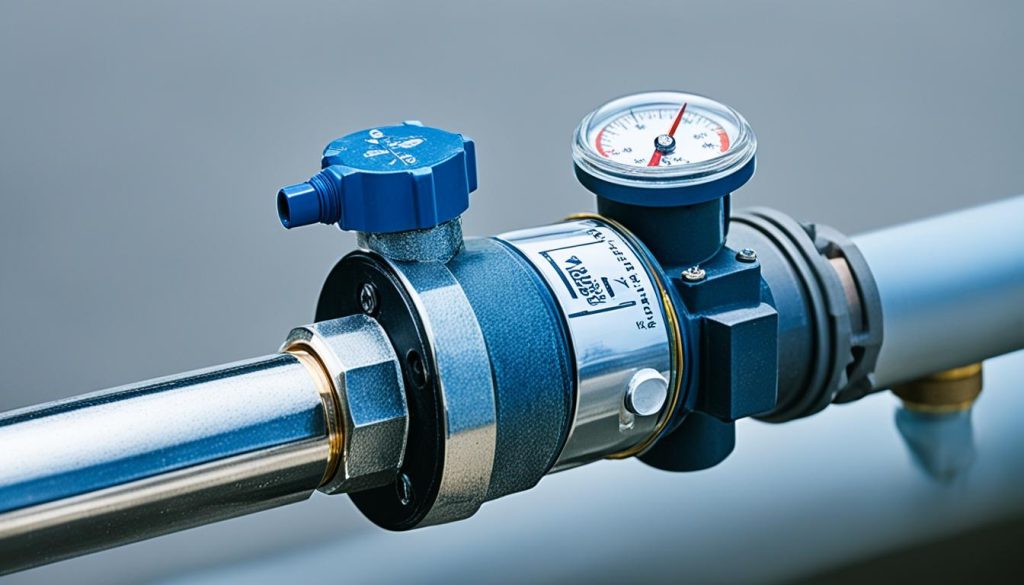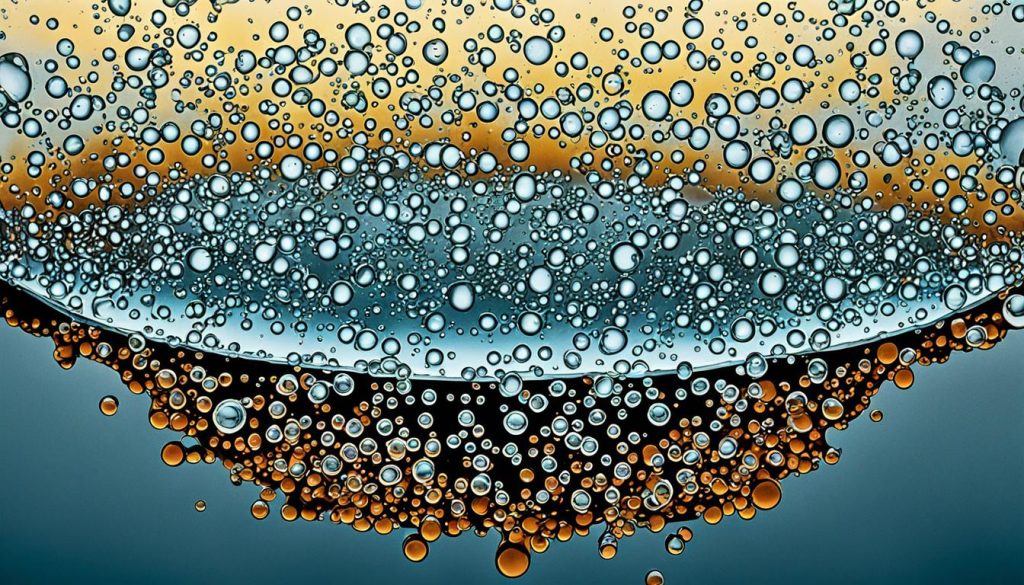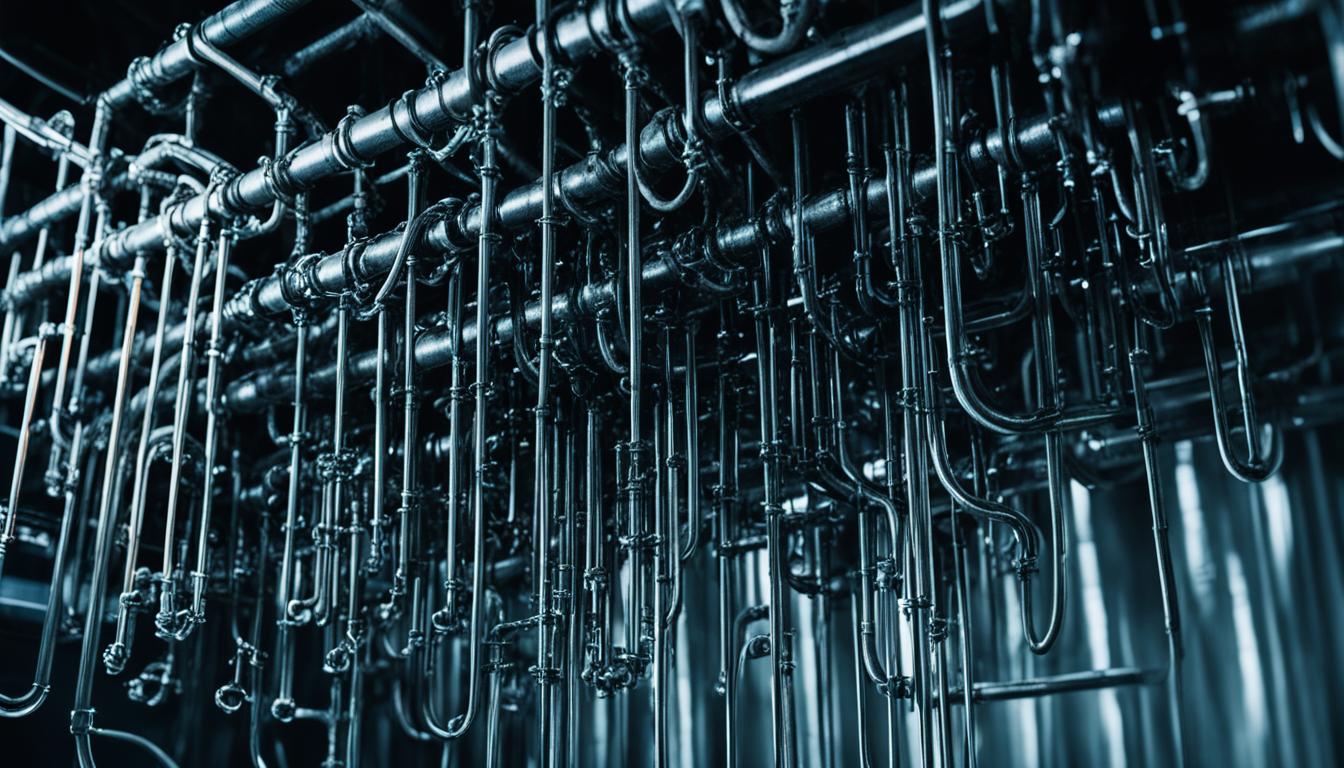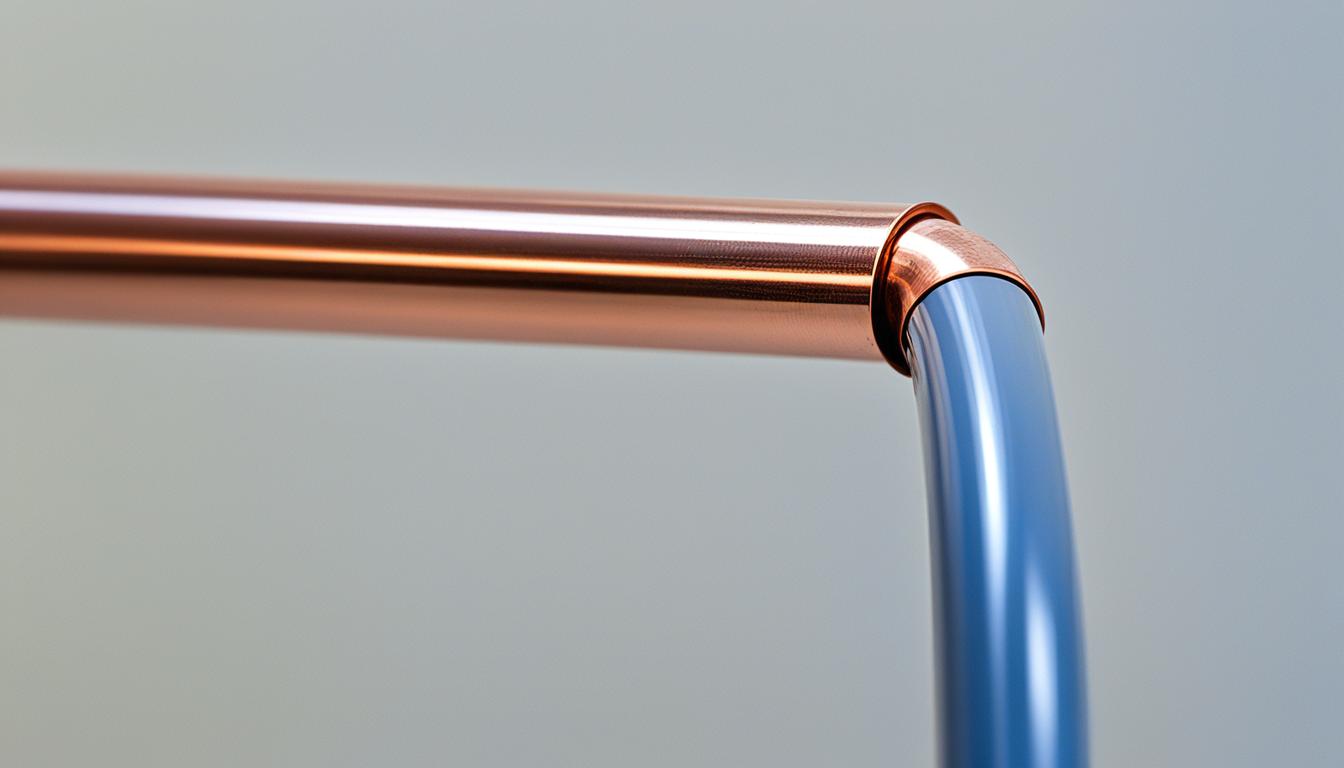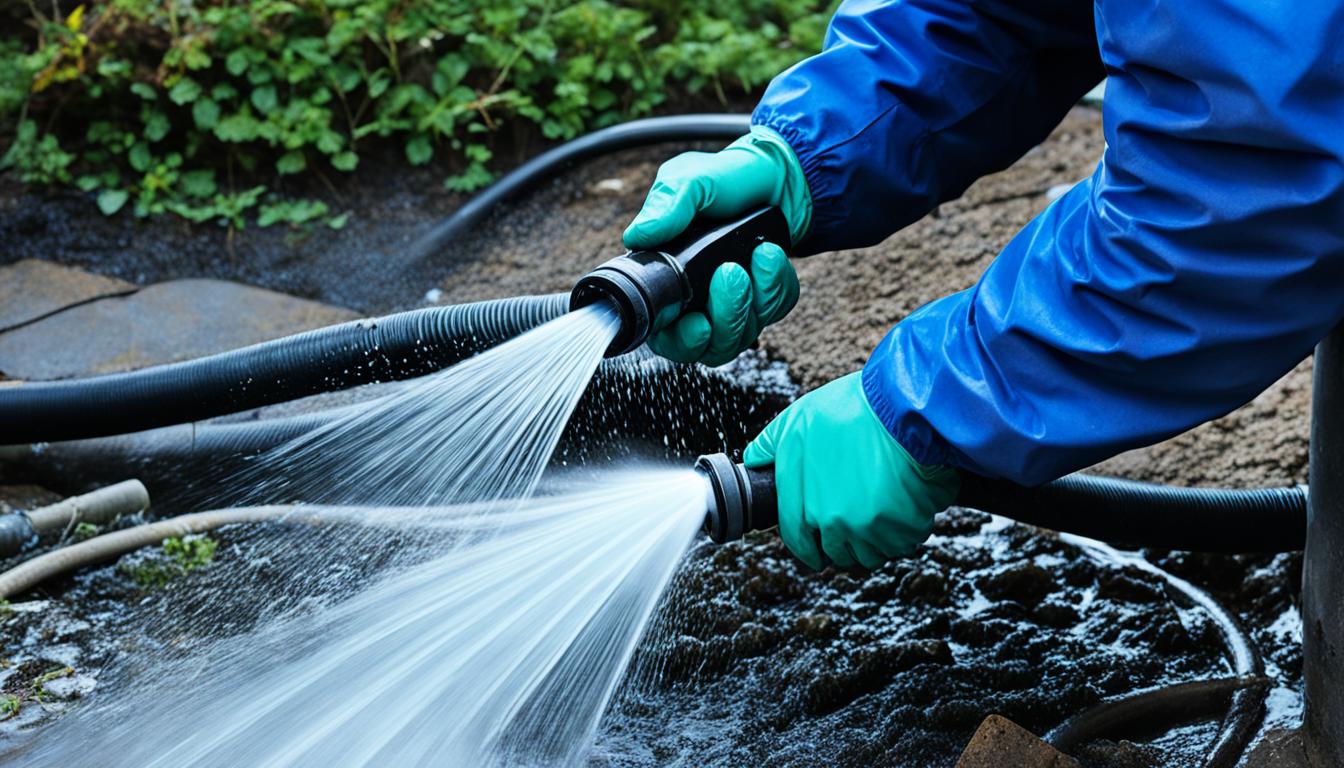Pipes Making Noise When Water Is Turned On? Fix It!
Did you know that noisy water pipes can be more than just an annoyance? In fact, according to a recent study, a staggering 80% of homeowners experience pipe noise when they turn on the water. If you’re one of them, fret not. In this article, I’ll share some valuable insights and effective solutions to help you troubleshoot and solve the problem of pipes making noise when water is turned on.
Key Takeaways:
- Several common causes, including high water pressure, water hammer, air bubbles, clogged pipes, and loose components, can result in noisy water pipes when the water is turned on.
- Understanding your residential plumbing system, including the service line, sanitary sewer line, hot water heater, p-traps, and appliances/fixtures, is crucial in identifying the root causes of pipe noise.
- Fixing high water pressure and water hammer can be achieved by installing a water pressure regulator or pressure-reducing valve, as well as water hammer arrestors.
- Air bubbles can be eliminated by resetting the air chambers, while clogged pipes may require the use of drain cleaners or augers to remove obstructions.
- To address noisy pipes caused by loose components, ensure fasteners, washers, and pipes are tightened or replaced as necessary.
Understanding Your Residential Plumbing System
To understand why your pipes are making noise, it is important to have a basic understanding of your residential plumbing system. The system consists of several key components that work together to provide water supply and drainage throughout your home.
The Service Line
The service line is the pipe that connects your home to the city’s main sewer line. It is responsible for bringing water into your home and removing wastewater. The service line is typically located underground and is connected to a water meter, which measures your water usage.
The Sanitary Sewer Line
The sanitary sewer line is a network of pipes that connects all the drains in your home to the city sewer line. It carries wastewater from your sinks, toilets, showers, and appliances to the city’s sewage treatment plant. Proper maintenance of the sanitary sewer line is crucial to prevent clogs and backups.
The Hot Water Heater
The hot water heater is an essential component of your residential plumbing system. It is responsible for heating the water that is supplied to your faucets, showers, and appliances. There are different types of hot water heaters, including traditional tank water heaters and tankless water heaters.
P-Traps
P-traps are curved pipes that are installed under sinks, tubs, and other fixtures. They serve two main purposes: preventing sewer gases from entering your home and acting as a barrier to retrieve objects that may accidentally fall down the drain. P-traps are an important part of your plumbing system to maintain proper hygiene and prevent odors.
Appliances and Fixtures
Your residential plumbing system is connected to various appliances and fixtures that require water supply and drainage. This includes sinks, toilets, showers, bathtubs, washing machines, dishwashers, and more. Each appliance and fixture has its own set of pipes and connections that contribute to the overall functionality of your plumbing system.
Having a clear understanding of your residential plumbing system is essential when troubleshooting issues such as noisy pipes. By knowing the different components and how they work together, you can better identify the possible causes and solutions to resolve any plumbing problems.
Common Causes of Noisy Pipes
Several factors can contribute to noisy pipes. High water pressure, water hammer, air bubbles, clogged pipes, and loose components can all cause various sounds in your plumbing system. Understanding these common causes is crucial in troubleshooting and resolving the noise issues in your home.
High Water Pressure
When the water pressure in your plumbing system is too high, it can create humming or vibrating sounds throughout the pipes. This can be due to a faulty pressure regulator or an issue with the municipal water supply. To solve this problem, consider installing a water pressure regulator to limit the water pressure to a safe level.
Water Hammer
Water hammer occurs when the flow of water is abruptly stopped, resulting in a loud banging noise. This can happen when a valve is closed too quickly, causing a sudden change in water flow. To prevent water hammer, you can install water hammer arrestors, which absorb the force of the water and eliminate the banging noise.
Air Bubbles
Air bubbles in the pipes can lead to bubbling or humming sounds. These air bubbles can enter the pipes through various means, such as during repairs or as a result of water line disruptions. To address air bubbles, it may be necessary to reset the air chambers in your plumbing system by turning off the main water supply valve and running all the taps to release the trapped air.
Clogged Pipes
Clogged pipes can cause sucking or gurgling noises as water struggles to flow through the obstructions. Common culprits of clogged pipes include hair, grease, food debris, flushable wipes, and even tree roots invading the sewer lines. To tackle clogged pipes, you can try using a drain cleaner or an auger to remove the blockage and restore proper water flow.
Loose Components
Loose components, such as worn washers or loose pipes, can result in rattling, whistling, or squealing sounds. These sounds are often caused by the vibrations created when water flows through the loose components. To address loose components, tighten or replace any worn washers, secure loose pipes with clips or plumber’s tape, and ensure all connections are properly fastened.
Fixing High Water Pressure and Water Hammer
If you’re dealing with high water pressure or experiencing the disruptive noise of water hammer, there are solutions available to address these issues. By installing a water pressure regulator or a pressure-reducing valve, you can effectively regulate and reduce the water pressure in your plumbing system. These devices ensure that the pressure remains within safe limits, preventing excessive strain on the pipes. Additionally, water hammer arrestors can be installed to absorb the force of the water and eliminate the banging noise caused by sudden valve closure.
To fix high water pressure and water hammer:
- Consider installing a water pressure regulator or a pressure-reducing valve to regulate the water pressure in your plumbing system.
- Consult a professional plumber to determine the appropriate device for your specific needs and requirements.
- Install water hammer arrestors to minimize the noise caused by sudden valve closure.
- Ensure that the devices are properly installed and maintained to effectively mitigate high water pressure and water hammer issues.
By taking these measures, you can restore peace and quiet in your home while protecting your plumbing system from potential damage caused by excessive water pressure.
Dealing with Air Bubbles and Clogged Pipes
Air bubbles in the pipes can disrupt the smooth flow of water and create unwanted noise. Luckily, there are steps you can take to address this issue. To resolve air bubbles, it is important to reset the air chambers in your plumbing system. This can be done by following these simple instructions:
- Locate the main water supply valve in your home.
- Turn off the main water supply valve to stop the flow of water.
- Next, open all the taps in your home, including faucets, showers, and tubs.
- Allow the taps to run until all the water has been drained from the pipes.
- Once you no longer hear water flowing from the taps, close them one by one, starting from the highest floor of your home and working your way down.
- Finally, turn the main water supply valve back on to restore water flow to your home.
Clogged pipes can also contribute to noisy plumbing. If you suspect that your pipes are clogged, it may be necessary to use a drain cleaner or an auger to remove the obstructions. Here are some tips to get rid of those pesky clogs:
- Start by using a plunger to see if you can dislodge the clog manually.
- If the plunger doesn’t work, try using a drain cleaner specifically designed for your type of plumbing system. Follow the instructions on the product packaging carefully.
- For more stubborn clogs, you may need to use an auger or a plumbing snake. Insert the auger into the drain and rotate it to break up the clog.
- If all else fails, it may be time to call a professional plumber to assess the situation and provide the necessary solutions.
By addressing both air bubbles and clogged pipes, you can restore peace and tranquility to your home plumbing system.
Addressing Loose Components
Noisy pipes can be a result of loose components such as fasteners, washers, or pipes. To resolve this issue, it is important to tighten or replace any loose fasteners and worn washers. This can be done using basic tools such as a wrench or pliers.
In the case of loose pipes, securing them is essential to prevent further damage and eliminate any rattling, whistling, or squealing noises in the plumbing system. One effective method is to use clips and plumber’s tape to hold the pipes in place. By providing stability and support, clips and plumber’s tape ensure that the pipes remain securely attached to their respective fixtures.
Addressing loose components is crucial in maintaining the integrity of your plumbing system. By doing so, you can prevent potential leaks, bursts, or further damage caused by loose pipes or fixtures. By tightening or replacing loose fasteners, worn washers, and securing loose pipes, you can enjoy a quieter and more efficient plumbing system in your home.
Source Links
- https://www.mrrooter.com/ronkonkoma/about-us/blog/2022/september/pipes-making-noise-top-5-causes-and-fixes/
- https://www.angi.com/articles/why-are-my-plumbing-pipes-making-noise.htm
- https://www.mrrooter.ca/about/blog/2018/february/why-are-my-water-pipes-so-noisy-/
- Investing Wisely: How Windows & Doors in Boost Property Value and Financial Health - April 24, 2025
- The Financial Impact of Personal Injuries: Why Legal Help Matters for Business Owners - April 16, 2025
- The Hidden Financial Costs of Domestic Assault: What Business Owners Need to Know - April 16, 2025
